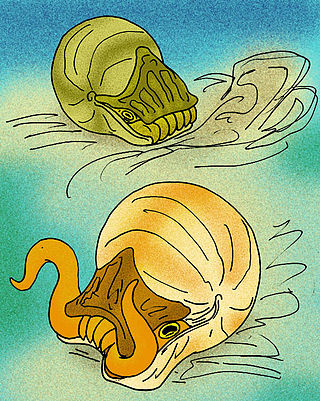
Ammonoids are a group of extinct marine mollusc animals in the subclass Ammonoidea of the class Cephalopoda. These molluscs, commonly referred to as ammonites, are more closely related to living coleoids than they are to shelled nautiloids such as the living Nautilus species. The earliest ammonites appeared during the Devonian, with the last species vanishing during or soon after the Cretaceous–Paleogene extinction event.

Goniatites is a genus of extinct cephalopods belonging to the family Goniatitidae, included in the superfamily Goniatitaceae. Hibernicoceras and Hypergoniatites are among related genera.
The Nautilina is the last suborder of the Nautilida and the only nautiloids living since the end of the Triassic. The Nautilina, proposed by Shimanskiy, is basically the Nautilaceae of Kummel, 1964, defined by Furnish and Glenister, but differs in omitting two families, the Paracenoceratidae and Pseudonautilidae which instead are placed in the Liroceratina.

Arcestes is a genus of extinct ceratitid ammonites found in Triassic-aged marine strata.
Frechites is an early Triassic ammonite, a kind of cephalopod with an external shell, included in the ceratitid family Beyrichitidae.
Ussuria is a genus of Lower Triassic ammonites with a smooth, involute discoidal shell with submonophyllic sutures, belonging to the ceratitid family Ussuriidae.

Medlicottiidae is a family of ammonoid cephalopods belonging to the Prolecanitida, known from the Upper Carboniferous (Pennsylvanian) to the Early Triassic.
Ussurites is an extinct ammonoid cephalopod genus belonging to the suborder Phylloceratina and is included in the family Ussuritidae. Its range is restricted to the early Middle Triassic, (Anisian)

Prolecanitida is an order of extinct ammonoid cephalopods, the major Late Paleozoic group of ammonoids alongside the order Goniatitida. Prolecanitids had narrow shells, discoidal (disc-shaped) to thinly lenticular (lens-shaped). They retained a retrochoanitic siphuncle, a simple form with septal necks extending backwards. As is typical for ammonoids, the siphuncle sits along the ventral margin of the shell.
The Clydonautiloidea are a superfamily within the nautiloid order Nautilida characterized by smooth, generally globular, shells with nearly straight sutures, in early forms, but developing highly differentiated sutures in some later forms. Where known, the siphuncle tends to be central to subcentral.
Syringonautilidae is a family of Nautiloidea from the middle to late Triassic. Syringonautilidae comprise the last of the Trigonoceratoidea and are the source for the Nautilaceae which continued the Nautiloidea through the Mesozoic and into the Cenozoic right down to the recent. Syringonautilidae is a strictly Triassic family, derived early in the Triassic from the Grypoceratidae.

Grypoceratidae is the longest-lived family of the Trigonoceratoidea, or of the near equivalent Centroceratina; members of the Nautilida from the Upper Paleozoic and Triassic.
The Clydonautilidae are Middle and Upper Triassic nautiloid cephalopods, which are derivatives of the clydonautiloidean family Liroceratidae, that have generally smooth, involute, globular to compressed shells, characterized by a suture with prominent lobes and saddles. The family is known to contain five genera, These are:
Holconautilus is a genus of nautiloids from the family Tainoceratidae and order Nautilida, named by Mojsisovics, 1902, and known from Upper Triassic sediments in Europe and E Indies (Timor). Its shell, evolute, discoidal, with simple coarse lateral ribbing; whorl section, subrectagular with a broadly arched venter.
Inyoites is an ammonoid genus from the Lower Triassic, included in the ceratitid family Inyoitidae.

Ophiceras is a genus of smooth, evolute ceratitid ammonites from the Early Triassic, with a rounded venter. Fossils of the genus have been found in Armenia, Azerbaijan, China, Greenland, and India.

Meekoceras is a genus of ceratitid ammonites with a discoidal shell that lived during the Early Triassic Epoch.
Clypeoceras is a genus of ammonites with an involute discoidal shell from the Lower Triassic.
Sturia is a genus of ceratitid ammonoids from the Lower Triassic with an ammonitic suture.
Proclydonautilus is a genus of nautiloids belonging to the Clydonautilidae known from the Upper Triassic of North America, Europe, and India.







